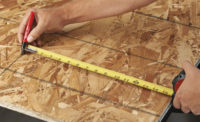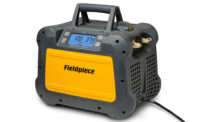Hand tools are an ever-shifting part of the HVAC landscape. Manufacturers are constantly developing new technologies with the goal of making life easier for technicians in the field.
In fact, Future Market Insights projects that during the forecast period 2017-2027, the global market for hand tools will showcase moderate growth, registering a compound annual growth rate (CAGR) of 3.9 percent.
In other words, hand tools are going to maintain their importance and value to contractors and technicians over the next decade.
Tools are becoming smarter, more compact, and more versatile. For contractors, these innovations provide opportunities to help enhance their team’s job site capabilities.
One particularly interesting development in the marketplace has been the onset and popularization of all-in-one hand tools or multifaceted offerings. Items such as multi-drill screwdrivers, multi-tools with different plier types have entered the conversation.
Technicians have not universally embraced these product types, though, recognizing that while they offer advantages, they also present some drawbacks in the field.
A POPULAR RESPONSE
Scott Savidge, technical leadership team, Isaac Heating & Air Conditioning, Rochester, New York, believes multi-tools have come a long way in recent years.
“With the advancement in technology, overseas production, and multiple manufacturers competing for dollars from professionals, the options available to technicians have become ever increasing,” he said. “From simple screwdrivers to wire strippers, saws and knives to pliers, I use my multi-tool daily. Nothing beats having a versatile tool on your belt when you’re stuck in an attic or crawlspace.”
Steve Moon, president, Moon Air Inc., Elkton, Maryland, agreed that the multi-bit screwdriver has become a very popular tool.
“I don’t know of a technician who is not using them because they make life much easier than carrying a bunch of drivers.”
However, Moon said multi-tools that try to feature too many things are not as common among technicians. Tools that provide everything from pliers, wire cutters, wire strippers, knives, and even scissors are less prevalent.
“Most of them are not of the quality a professional requires,” he said. “I have one in my motorcycle saddle bag but not in my tool pouch. Pliers seem to be more specialized, and most of the places where they are used is a confined area where extra space for the bulking folding tool is just not there. It is a lifestyle change. I am sure there are guys out there who love them, I am just not one of them.”
One guy who is a fan of these offerings is Christopher Dion, senior service technician, DHR Mechanical Services Inc., Sanford, Florida.
“As a contractor, I utilize both stand-alone and all-in-one tools,” he said. “I find the convenience of the all-in-one tools very useful and utilize them for most service calls. However, when it comes to completing a project or install, I always go to my heavy tool bag with dedicated tools.”
The majority of technicians at Flame Heating, Cooling, Plumbing, and Electrical in Warren, Michigan, have both all-in-one tools as well as single-use tools in their bag, according to Matt Marsiglio, operations manager.
“The most popular multiuse hand tool we see is the 10-in-1 screwdriver, which allows our service technician to have a smaller tool pouch when entering a home,” he said. “On the service side of our business, we see these tools utilized much more than on the install side. I would say hand tools are not getting too complicated, but, with the number of options available from different manufactures, I believe it is a tougher decision on what tools to purchase.”
POTENTIAL DRAWBACKS
Dion said his largest complaint with all-in-one tools is the struggles he has seen with them holding up to continuous, daily use. This was a common refrain from contractors, as they appreciate versatility and having numerous options at their fingertips, but the job site requires excessively durable tools that can hold up to rigorous use on a daily basis.
“In most cases, purchasing these tools requires either significant investment in the better quality tools or repeated purchasing of the cheaper variants,” said Dion.
“For example, in my light tool bag, I have an 11-in-1 combination needle-nose plier stripper, multi-bit hex driver, and a multimeter with a thermocoupler. Meanwhile, my heavy tool bag has all dedicated tools and independent meters, including a phase monitor, megger, tachometer, velometer, sling, and dual-port manometer.”
Tye Leishman, president, Tempco Heating & Cooling Specialists, Powell River, British Columbia, Canada, is a fan of the multi-tools, and, in contrast to Dion, has chosen to incorporate the multi-tool offerings into his team’s daily work routine.
“All our techs have a full and heavy backpack with every tool you can think of, but if we are going up on a roof to troubleshoot a rooftop unit, we grab our multimeter, small crescent wrench, and multi-tool. These will cover you for most situations, and, if need be, you can always go and grab your tool bag when required.”
Leishman does have certain reservations about all-in-one tools though. He doesn’t believe there is a total all-in-one option to replace an entire bag of tools.
“An all-in-one is better designed to be used like an initial attack tool,” he said. “It will get you started in the right direction, but you don’t want to rely on a multi or an all-in-one for heavy repetitive use. Every technician should have, at a minimum, one multi-bit screwdriver in their tool bag.”
Savidge said nothing beats having one tool in your pocket instead of six when attempting to investigate the unknown situations that can pop up on a routine service call.
“From ratcheting handles to ergonomic grips, manufacturers have delivered by providing versatility and repeat customers when the simple 6-in-1 turns to a 4-in-1 and, ultimately, a 2-in-1 as bits are lost.”
Savidge also noted that the term multi-tool should not be limited to just the traditional hand-tool arena.
“While ‘old school’ analog refrigeration gauges are still commonplace, digital gauges on steroids have taken the market by storm in recent years,” he said. “All the major manufacturers have jumped on board. These products allow users to test multiple pressures, temperatures, enthalpy, volts, amps, evacuation, and airflows, which will be analyzed to provide precise calculation and documentation to ensure the customer has a perfectly operating system.
“Tool systems such as this come at a price for initial investment but can differentiate your company,” Savidge added.
“When a trained technician is at a customer’s home and uses specialized tools that his competitors will not be using, you likely have a satisfied customer and repeat sales opportunities.”
Publication date: 11/6/2017
Want more HVAC industry news and information? Join The NEWS on Facebook, Twitter, and LinkedIn today!













